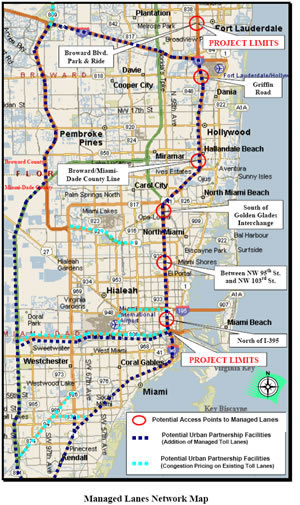Miami Urban Partnership Agreement
Miami Urban Partnership Agreement
Additional Information
Phase 1 Transit Evaluation Report (PDF 2.3MB)
Phase 1A - Transit Evaluation Report (PDF 3MB)
95 Express Midyear Report (October 30, 2009) (PDF 2.38MB)
Creation of a Priced, Managed Multi-Lane Network
The Miami-Ft. Lauderdale region created a 21-mile managed-lane facility on I-95, between I-395 and I-595, with a longer term goal of providing a network of managed lanes throughout the congested region. Free-flowing conditions on the managed-lane network are ensured through the use of variable pricing based upon demand and the network is now being used as the back-bone of a bus rapid transit (BRT) system which will is subsidized through the toll revenues. Toll rates adjust as often as every three minutes in order to maintain free-flowing conditions on the managed lanes at least 90 percent of the time.
This is the second project in the nation (after the Houston QuickRide project) to increase the occupancy requirement on high-occupancy vehicle (HOV) lanes, in this case from HOV 2+ to HOV 3+. The new occupancy requirement ensures that the lanes remain free-flowing as HOV demand increases in the future, and will create some excess capacity for priced vehicles. The previously open access to the HOV lanes no longer exists. The facility uses delineator posts and provides access at strategically chosen locations, enhancing traffic flow and safety on the lanes. Open road tolling at freeway speeds occurs through the use of "SunPass" toll transponders and electronic readers and through video license plate readers. (Currently, 63 percent of toll transactions in the region are by SunPass, climbing to 80 percent at certain locations during commute hours.) Changeable message road signs will show the current price for vehicles not meeting the occupancy requirement to use the managed lanes. A camera-based violation enforcement system is in operation.
The 21-mile I-95 express facility converted a single HOV lane into two high-occupancy toll (HOT) lanes in each direction by narrowing the travel lanes from 12' to 11' and narrowing the shoulders. Construction included some bridge and interchange improvements to maintain continuity of the dual managed lane facility. Phase 1-A of the project, the southern half of northbound lanes opened in 2008. Phase 1-B opened in 2010.
Other Supporting Urban Partnership Elements
In addition to pricing the managed lanes to reflect demand, the Florida Department of Transportation improved traffic conditions in the corridor by installing ramp meters on I-95 south of the Golden Glades interchange. Other traffic management strategies that serve the new managed-lane network, including traffic management cameras coupled with "Road Ranger" full-service patrols and rescue services.
The I-95 express lanes serves as an important part of the BRT service network. For passengers boarding BRT vehicles at the Golden Glades interchange park-and-ride lot and heading the 11 miles south into Miami, bus speeds have dramatically increased as a result of the corridor improvements, from the previously 22 mph. Additional BRT vehicles will be purchased to expand this service. Express feeder bus services are also now offered, running north-south along US-441/SR-7 and SR-817, and east-west along Hollywood/Pines Boulevard. The service network operates on the managed expressway lanes as well as on special-use lanes on three major arterials: Biscayne Boulevard, Flagler Street, and Kendall Drive.
Additional related improvements allow transit vehicle priority at 50 signalized intersections, uniquely brand two new express/BRT stations in Broward County, and construct pedestrian access accommodations at one of the two new stations.
To round out the congestion-reduction plan, the Chamber of Commerce led efforts to encourage telecommuting, flextime, and employer-sponsored ride-sharing. This effort is sponsored by South Florida Commuter Services, which, among other things, already works with the business community to promote vanpooling. South Florida Commuter Services is funded by the Florida Department of Transportation.
You may need the Adobe Acrobat Reader to view the PDFs on this page.

